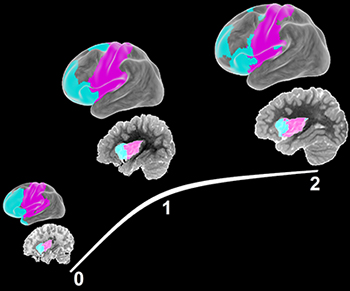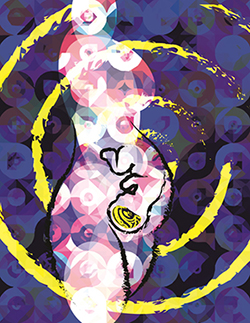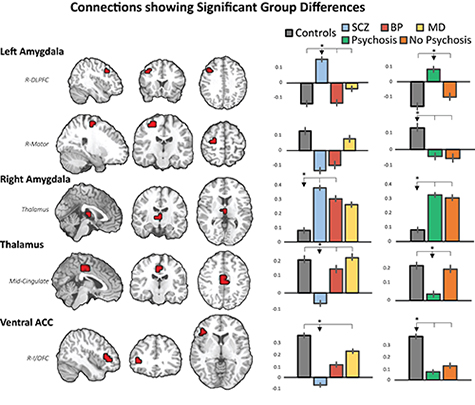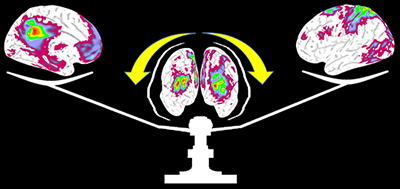Research Areas
Normal Brain Development Study

| Longitudinal development of insula functional specialization and associated network structure during infancy. |
By longitudinally following typically developing infants throughout the first years of life, we have studied the normal early brain development process using leading-edge resting-state fMRI (rsfMRI) imaging techniques and infant-specific behavioral testing strategies. Quantitative delineation of the developmental trajectories of different functional brain networks during infancy was extremely challenging until the advent of the rsfMRI technique, which can image infant brain functional organization during natural sleep. Using this advanced technology, we have documented the emergence and evolution of various functional networks during the first years of life. Our findings revealed significant local functional specialization, long-distance functional integration, and whole brain system optimization during normal brain development within this critical period. Overall, the normative functional development trajectories at different levels are characterized by a nonlinear trend featuring the most dramatic growth during the first year. These studies pave the way for study of abnormal development associated with genetic/environmental risks or brain disorders.
At Cedars-Sinai, the Gao Laboratory will continue our exploration into this exciting area and further look into the gut-brain axis during the critical infancy period with the aim of identifying new targets for early identification of risks and/or intervention.
Abnormal Brain Development due to Genetic and/or Environmental Risks

| Genetic/environmental risk factors significantly alter early brain functional development. |
Specifically, we have studied offspring of mothers diagnosed with psychiatric disorders such as schizophrenia, bipolar disorder, and so on (representing genetic risks) and mothers using recreational drugs such as cocaine and marijuana during pregnancy (representing environmental risks). By imaging their offspring at the neonatal stage, our design minimizes other postnatal environmental confounds (caregiving quality, socioeconomic status, etc.) commonly associated with maternal psychiatric disorders and/or substance abuse, thus enabling us to delineate the more-direct brain mechanisms associated with genetic or environmental risks. Our results consistently demonstrate that critical functional circuits already show risk-related abnormalities in neonates. More importantly, these functional circuit deficits significantly predict later behavior outcomes.Based on the Gao Lab's extensive experience in studying normal brain functional development during infancy, we have recently begun to look into abnormal development due to genetic and/or environmental risks.
These studies demonstrate that the footprint of genetic and environmental risks on the brain's functional organization can be detected as early as in neonates. Such early detection is critical for the development of potential biomarkers for early identification of risks and for guiding intervention.

| Functional connectivity changes in neonates whose mothers were diagnosed with schizophrenia (SCZ), bipolar disorder (BP), and mood-disorder not-otherwise-specified (MD), compared with normal controls (Controls). |
Adult Brain Functioning and Brain Disorders/Diseases
Recently, the notion that the brain operates on large-scale functional networks with dynamic interactions during different brain states has been increasingly accepted. Better understanding of such network-level dynamics in matured human brains will not only improve our understanding of the adult brain functioning mechanisms but also help the delineation of abnormal mechanisms in different brain disorders/diseases. The Gao Lab has documented, in normal adults, a potential regulating role of the frontoparietal control network between the anti-correlated default-mode and dorsal attention networks, the differential interaction mechanisms between the salience and executive control networks under task perturbations, the dynamic reorganization of the default-mode network across different behavioral states, and the task-modulation of functional connectivity variability.
At Cedars-Sinai, the Gao Laboratory will actively expand our normal adult studies to other brain disorders/diseases to explore the translational potential of different fMRI tools in diagnosing and monitoring brain pathology.

Frontal parietal control network regulates the anti-correlated default-mode and dorsal attention networks to facilitate the switching between contrasting behaviors in normal adults. |
Contact the Gao Lab
8700 Beverly Blvd.
Biomedical Imaging Research Institute
Los Angeles, CA 90048